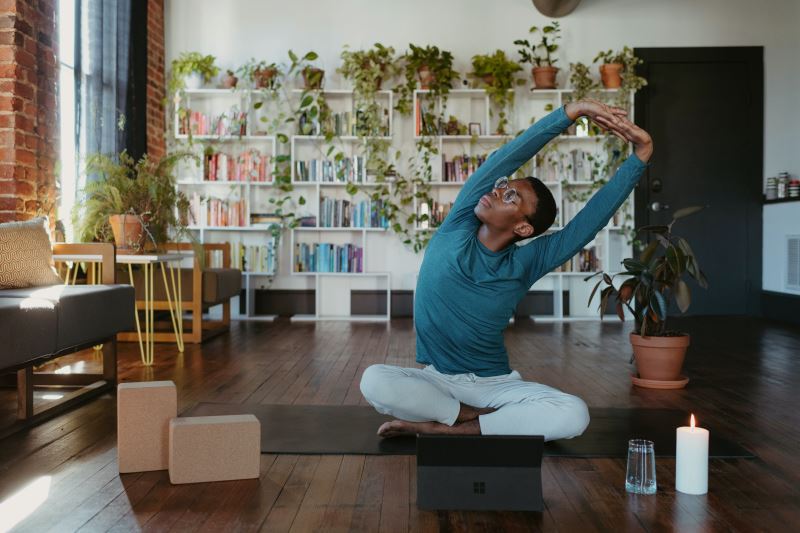Though a fear of heights can seem impossible to overcome, it can be managed with the right treatment. Whether via the NHS or private routes, there are various types of therapy that people with acrophobia can take advantage of. There’s also medication and self-management techniques to consider. But which treatment is best for acrophobia?
In this article, we’re going to walk you through the various types of treatment for acrophobia and shed light on which ones are most effective. Let’s go!
Table of contents
Self-management

Those with mild to moderate acrophobia often attempt to treat their condition themselves before moving on to look for professional help. There are certainly a few methods which can help reduce the severity of acrophobia and teach individuals to tolerate situations that trigger their fear of heights.
Setting actionable goals
Though staying away from the things that can trigger your acrophobia symptoms may work on a short-term basis, it can actually exacerbate your overall condition when you accidentally encounter heights.
The best thing to do is set yourself small, actionable goals that will help you learn to tolerate heights and manage your symptoms. You can start by making a list of what triggers your acrophobia and ordering the items from what scares you the least to what scares you the most.
As an example, the mildest fear on your list might be standing on a ladder so that you can change a lightbulb. The most intense fear, however, might be standing on a top floor balcony during the day.
You can then gradually make your way through the list one at a time. It helps to run through each scenario several times so that you can build up a tolerance. If you’re tackling escalators, for example, you would practise using them multiple times a day over a prolonged period of time. The aim is to eventually reach a point where you can face your fears without feeling the urge to flee.
Relaxation techniques
If you know that you’re going to encounter heights at some point during your day, you can use relaxation techniques to help you cope with the stress and anxiety that will occur due to your condition.
This can include:
- Yoga
- Meditation
- Breathing exercises
- Regular exercise
- Muscle relaxation training
Take care of yourself
Taking adequate care of your body will put you in the right frame of mind to tackle your phobia. To ensure that you’re in tip-top shape, you should:
- Stick to a healthy, well-balanced diet
- Consider switching to decaffeinated drinks, as caffeine can worsen anxiety
- Try to be physically active
Therapy

If self-management techniques aren’t effective enough, or the condition is too severe, the next step is usually professional help. Though it’s not always possible to cure a phobia, you can make your symptoms more manageable through a range of treatments.
Exposure therapy
One of the most common treatments for acrophobia is in vivo therapy, otherwise known as exposure therapy. In order to manage a phobia, you must gradually learn how to face your fear. This is the primary focus of exposure therapy. It encourages patients to slowly expose themselves to the situations that trigger their fear in order to help them adapt to it.
A patient might start out by looking at pictures or videos that involve heights, before working up to testing themselves against heights in person. They might begin with looking out of a first floor window before slowly making their way up to the next floor. Over the course of several sessions, the patient will learn to tolerate and manage the symptoms that are triggered by their proximity to heights.
Exposure therapy can typically take anywhere from 6 to 15 sessions to produce results, depending on the intensity of the condition and how quickly a patient works through the process. It can be carried out using self-help books, but it’s usually most effective when conducted by a professional therapist.
Pros
- It is an effective method for helping people learn to tolerate their phobia
- It can have a long-lasting positive effect on an individual’s life
- It requires relatively little time
Cons
- It can be deeply upsetting for individuals to have to confront their fears
- Patients have to be completely committed for it to work effectively
- Symptoms can return if the patient doesn’t complete the full treatment
Virtual reality exposure therapy
If in vivo therapy causes too much discomfort, then VR exposure therapy is often the next port of call. Rather than urging patients to face their fears in person, a therapist will use a headset to show them a series of realistic simulations that involve heights. This method borrows techniques from gaming, allowing for an immersive experience.
A key benefit of this therapy is that it can expose patients to their fears in a way that is completely safe. If a patient has an adverse reaction, all they need to do is take off their headset. By contrast, in vivo exposure can sometimes leave people frozen with fear and unable to walk away from situations they are struggling with.
Given that VR therapy can take place entirely in an office, the patient is also able to avoid any humiliation or embarrassment that can sometimes come with confronting one’s fear in public. It also gives the therapist far more power and control over the situation. They’re able to pick the exact scenario, its duration and its intensity.
For those with intense acrophobia, VR exposure therapy represents a gateway towards gradually exposing themselves to heights in person.
As with in vivo therapy, VR exposure therapy can take anywhere from 6 to 15 sessions to complete.
Pros
- It’s less intimidating to confront heights virtually than it is in person
- The patient is able to take off the headset if the scenarios become too overwhelming
- It’s a great stepping stone for in vivo therapy
Cons
- Not all therapists have access to the technology required for VR
- It’s not as completely immersive as in vivo therapy
Cognitive behavioural therapy
Cognitive behavioural therapy (CBT) helps patients make sense of their phobia by breaking down the way that they approach heights into five key areas:
- Situations
- Thoughts
- Emotions
- Physical symptoms
- Actions
These key areas are all connected. When someone with acrophobia is in a situation involving heights, their negative thoughts about the scenario will affect the way that they feel emotionally and physically. This then creates an endless cycle of negative and irrational thoughts, feelings and behaviours.
By identifying these thought processes, however, a patient can gain some perspective and replace them with more accurate and logical thoughts. Instead of panicking about falling out of a window on the top floor, for example, the patient is able to remind themselves that they’re much safer than they originally thought.
Once the therapist is able to help the patient reframe their thoughts and beliefs, they may incorporate elements of exposure therapy into the mix so that they can learn to face their fears in person without being triggered.
CBT can take anywhere between 5 to 20 sessions lasting 30 to 60 minutes. It depends on the severity of a patient’s condition and the intensity of their sessions. It can be carried out in person, or online.
Pros
- CBT has a lot of structure which makes it beginner-friendly and very accessible
- It can be completed in a short period of time compared to other therapies
- It teaches patients practical strategies that can be used well after treatment has ended
Cons
- You have to commit to the work for it to be effective
- It can be difficult to hear that your thoughts are irrational or ‘wrong’
- It depends on the patient’s capacity to change themselves
Eye movement desensitisation and reprocessing (EMDR) therapy
EMDR therapy works by helping patients reprocess traumatic memories that involve their fear of heights so that they no longer incite strong feelings of distress.
This therapy will usually begin with the patient identifying their worst experience with heights. The therapist will then ask the patient to recall this memory as they move their eyes side to side—following the movement of the therapist’s finger, or a tapping noise. This bilateral movement will allow patients to reprocess the event without getting overwhelmed by their fear.
Over time, the patient will be able to recall even the most traumatic of memories involving heights without triggering emotional and physical symptoms.
The therapist will also teach the patient a range of self-control techniques so that they can learn to manage their symptoms when they encounter heights.
EMDR can take between 6 to 12 sessions to complete, depending on the severity of the patient’s condition. It can be carried out in person, or virtually.
Pros
- EMDR is effective for reprocessing distressing memories
- It can be completed in a short amount of time
- It teaches patients self-control techniques that can be used after they’ve completed their treatment
Cons
- It can be difficult to face traumatic memories
- It can lead to vivid dreams or the emergence of new traumatic memories
- Patients can experience a range of unwelcome emotional and physical sensations during EMDR
Hypnotherapy
In hypnotherapy, a patient will work with a therapist to enter a relaxed, trance-like state. During this time, the therapist will use guided imagery and other suggestive techniques to help the patient think about heights and their related fear response(s) differently. These sessions may even reveal the origin of the phobia.
As the patient imagines themselves facing heights, the therapist will help them dissociate from their fear by taking the emotional triggers from their subconscious mind. In essence, they’re changing the patient’s perspective—creating new neural pathways to help them behave and react differently to situations that would usually trigger their fears.
Contrary to popular belief, the patient retains full control when undergoing hypnotherapy for acrophobia. If they feel uncomfortable or distressed at any point during the session, they are able to ‘resurface’ whenever they like.
Gradually, the patient will confront situations that would usually trigger their phobia so that they can put the techniques they’ve been taught into practice. Over time, the patient will no longer associate heights with the same feelings of terror and helplessness.
The duration of hypnotherapy will depend on the hypnotherapist and the severity of the patient’s acrophobia. You’re typically looking at anywhere from 4 to 15 sessions in total.
Pros
- The patient is in full control so they can end the session whenever they’d like
- Patients can use the techniques shown to them to manage their fear outside of their sessions
- If the patient has severe acrophobia, hypnotherapy might be less traumatic than treatments such as exposure therapy
Cons
- In the UK, hypnotherapists aren’t required to undergo professional training, so patients need to be careful when picking a hypnotherapist
- It has varying levels of success depending on the individual and the severity of their phobia
Medications

There isn’t a specific medication to treat acrophobia, but individuals with the condition can take medication to help them manage their anxiety when they’re in a situation in which they can’t avoid their fear.
The duration of treatment will vary depending on the prescribed medication.
Beta blockers
Beta blockers are commonly used to treat cardiovascular conditions, such as heart problems and high blood pressure, but can also help to reduce the symptoms of anxiety. They work by slowing down a patient’s heart rate and decreasing their blood pressure.
Common side effects include:
- Stomach issues
- Cold fingers
- Tiredness
- Sleep problems
Benzodiazepines
Benzodiazepines, like diazepam, are minor tranquilisers that can be used at the lowest dose possible to treat severe anxiety. As they can become addictive, they’re prescribed on a short-term basis only. When it’s time for a patient to stop using them, the dose needs to be gradually reduced to avoid triggering withdrawal symptoms.
Antidepressant medications
Antidepressants like selective serotonin reuptake inhibitors (SSRIs) can be prescribed to acrophobes to reduce symptoms of anxiety and depression that are caused by their fear.
SSRIs usually need to be taken for at least 2 to 4 weeks for benefits to be felt by a patient. Treatment will usually continue for at least 6 months after the patient feels better, though a longer course may be recommended if the condition is severe.
What’s the best treatment for acrophobia?
Whilst it is possible to reduce the severity of acrophobia through self-management, its effectiveness will vary from person to person. For people who use avoidance strategies and find themselves struggling to merely think about heights, professional therapy is the best treatment.
Your choice of therapy, however, will depend on your preferences and how severe your condition is. Climb Above Fear can make this decision easier for you. All you have to do is fill out our consultation form and one of our therapists will get in touch with you to provide a free assessment and recommend a course of action that will best suit you.
If your fear of heights has caused you to change the way you live your life, it’s time to take control and climb above your fear today.



